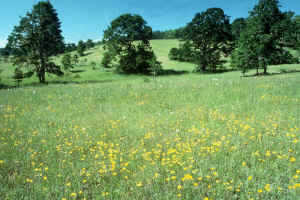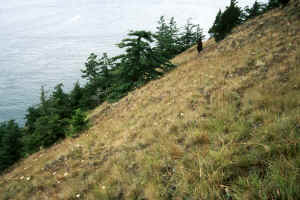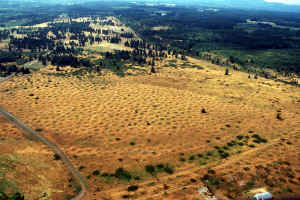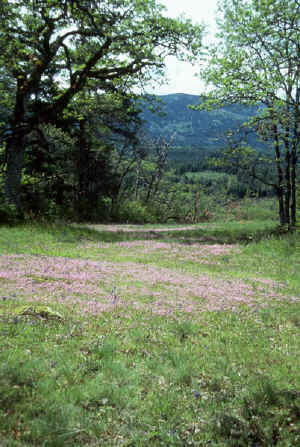No. 11. Westside Grasslands
Christopher B. Chappell and Jimmy Kagan
Geographic Distribution. This habitat is restricted primarily to the
Puget Lowland and Willamette Valley ecoregions, with most now occurring in
Pierce, Thurston, and San Juan counties, Washington. It also occurs in scattered
small outliers in the Coast Range of Oregon and the western Columbia Gorge of
Washington (Skamania County) and in adjacent southwestern British Columbia.
 Physical Setting. The climate is mild and moderately dry (17-55 inches
[43-140 cm] mean annual precipitation), with moist winters and dry summers.
Elevation is mostly low and ranges up to a maximum of about 3,500 ft (1,067 m).
Topography varies from flat, to mounded or rolling, to steep slopes. Most sites
are topoedaphically dry and experience extreme soil drought in the summer. Much
of what currently remains of this habitat is found on the South Puget prairies,
which are underlain by very deep gravelly/sandy glacial outwash that is
excessively well drained. Many other small sites, often called "balds",
have shallow soils overlying bedrock and typically are on south- or west-facing
slopes. The habitat also occurs rarely in Oregon on deeper soils that are not
excessively drained. Physical Setting. The climate is mild and moderately dry (17-55 inches
[43-140 cm] mean annual precipitation), with moist winters and dry summers.
Elevation is mostly low and ranges up to a maximum of about 3,500 ft (1,067 m).
Topography varies from flat, to mounded or rolling, to steep slopes. Most sites
are topoedaphically dry and experience extreme soil drought in the summer. Much
of what currently remains of this habitat is found on the South Puget prairies,
which are underlain by very deep gravelly/sandy glacial outwash that is
excessively well drained. Many other small sites, often called "balds",
have shallow soils overlying bedrock and typically are on south- or west-facing
slopes. The habitat also occurs rarely in Oregon on deeper soils that are not
excessively drained.
 Landscape Setting. This habitat occurs adjacent to or in a mosaic with
Westside Riparian-Wetlands, Westside Oak and Dry Douglas-fir Forests and
Woodlands, Agriculture, or Urban habitats. Westside grassland habitat
occurs less commonly in a matrix of Westside Lowland Conifer-Hardwood Forest. In the San Juan
Islands, the habitat sometimes occurs on bluffs or slopes adjacent to marine
habitats. Currently this habitat is used for grazing, recreation, and, in the
southern Puget Sound area, for military training. Landscape Setting. This habitat occurs adjacent to or in a mosaic with
Westside Riparian-Wetlands, Westside Oak and Dry Douglas-fir Forests and
Woodlands, Agriculture, or Urban habitats. Westside grassland habitat
occurs less commonly in a matrix of Westside Lowland Conifer-Hardwood Forest. In the San Juan
Islands, the habitat sometimes occurs on bluffs or slopes adjacent to marine
habitats. Currently this habitat is used for grazing, recreation, and, in the
southern Puget Sound area, for military training.
Structure. This habitat is grassland or, less commonly, savanna, with
<30% tree or shrub canopy cover. Bunchgrasses predominate in native-dominated
sites, with space between the vascular plants typically covered by mosses,
fruticose lichens, or native forbs. Montane balds are sometimes dominated in
part by short forbs (<1.6 ft [0.5 m]) or dwarf-shrubs. Degraded sites are dominated by rhizomatous
exotic grasses with some native herbaceous component still present. Scattered
trees are either evergreen conifers or deciduous broadleaves. Shrubs may be
absent, scattered, or very prominent, and include evergreen and deciduous
broadleaf physiognomy.
 Composition. The major native dominant bunchgrass is Roemerís fescue (Festuca
idahoensis var. roemeri). Red fescue (F. rubra) and California
oatgrass (Danthonia californica) are frequently dominant or co-dominant
on a local basis. Long-stolon sedge (Carex inops) is occasionally
co-dominant, especially in savannas and in the Columbia Gorge. Slender wheatgrass (Elymus trachycaulus),
blue wildrye (Elymus glaucus), prairie junegrass (Koeleria macrantha),
and Lemmonís needlegrass (Stipa
lemmonii) can be important locally. Major exotic dominant species are
colonial bentgrass (Agrostis capillaris), sweet vernalgrass (Anthoxanthum
odoratum), Kentucky bluegrass (Poa pratensis), tall oatgrass (Arrhenatherum
elatius), medusahead (Taeniatherum caput-medusae), tall fescue (F.
arundinacea), and soft brome (Bromus mollis). Common camas (Camassia
quamash) is probably the most important forb in terms of cover, but it
rarely dominates. The bracken fern (Pteridium aquilinum) is sometimes
co-dominant. A rich diversity of native forbs is typical of sites in good
condition. Composition. The major native dominant bunchgrass is Roemerís fescue (Festuca
idahoensis var. roemeri). Red fescue (F. rubra) and California
oatgrass (Danthonia californica) are frequently dominant or co-dominant
on a local basis. Long-stolon sedge (Carex inops) is occasionally
co-dominant, especially in savannas and in the Columbia Gorge. Slender wheatgrass (Elymus trachycaulus),
blue wildrye (Elymus glaucus), prairie junegrass (Koeleria macrantha),
and Lemmonís needlegrass (Stipa
lemmonii) can be important locally. Major exotic dominant species are
colonial bentgrass (Agrostis capillaris), sweet vernalgrass (Anthoxanthum
odoratum), Kentucky bluegrass (Poa pratensis), tall oatgrass (Arrhenatherum
elatius), medusahead (Taeniatherum caput-medusae), tall fescue (F.
arundinacea), and soft brome (Bromus mollis). Common camas (Camassia
quamash) is probably the most important forb in terms of cover, but it
rarely dominates. The bracken fern (Pteridium aquilinum) is sometimes
co-dominant. A rich diversity of native forbs is typical of sites in good
condition.
The most common savanna tree is Douglas-fir (Pseudotsuga menziesii).
Oregon white oak (Quercus garryana) formerly was part of extensive
savannas, but is now rare in that structural condition. Ponderosa pine (Pinus
ponderosa) is very local. The most common shrub is the exotic species Scotís
broom (Cytisus scoparius), which frequently forms open stands over the
grass. Common snowberry (Symphoricarpos albus), Nootka rose (Rosa
nutkana), poison- oak (Toxicodendron diversilobum), and serviceberry
(Amelanchier alnifolia) are other common shrubs. The dwarf shrubs
kinnikinnick (Arctostaphylos uva-ursi) and common juniper (Juniperus
communi) sometimes dominate small areas in montane balds, and the former
sometimes on the Puget Sound prairies. Racomitrium canescens is the most
common ground moss.
 Other Classifications and Key References. Portions of this habitat have
been referred to as prairies by many authors. Franklin and Dyrness 88
described this habitat as prairie in the Puget Sound area, grassland in the San
Juan Islands and Interior Valley zone of Oregon, and grass balds in the Oregon
Coast Range. The Oregon Gap II Project 126 and Oregon Vegetation
Landscape-Level Cover Types 127 effort did not map this type; it was
inadvertently aggregated with the agriculture classification. The Washington Gap
project mapped this habitat as part of nonforested in the Woodland/Prairie
Mosaic Zone. Other references describe elements of this habitat7, 40, 41, 54, 99, 142,
211. Other Classifications and Key References. Portions of this habitat have
been referred to as prairies by many authors. Franklin and Dyrness 88
described this habitat as prairie in the Puget Sound area, grassland in the San
Juan Islands and Interior Valley zone of Oregon, and grass balds in the Oregon
Coast Range. The Oregon Gap II Project 126 and Oregon Vegetation
Landscape-Level Cover Types 127 effort did not map this type; it was
inadvertently aggregated with the agriculture classification. The Washington Gap
project mapped this habitat as part of nonforested in the Woodland/Prairie
Mosaic Zone. Other references describe elements of this habitat7, 40, 41, 54, 99, 142,
211.
 Natural Disturbance Regime. Historically, fire was a major component of
this habitat. In addition to occasional lightning strikes, fires were
intentionally set by indigenous inhabitants to maintain food staples such as
camas and bracken fern 165. Although there is no definitive fire
history information, evidence suggests that many, if not most, of these
grasslands burned every few years. Annual soil drought naturally eliminated or
thinned invading trees and promoted higher frequency fire regimes in the past. Natural Disturbance Regime. Historically, fire was a major component of
this habitat. In addition to occasional lightning strikes, fires were
intentionally set by indigenous inhabitants to maintain food staples such as
camas and bracken fern 165. Although there is no definitive fire
history information, evidence suggests that many, if not most, of these
grasslands burned every few years. Annual soil drought naturally eliminated or
thinned invading trees and promoted higher frequency fire regimes in the past.
 Succession and Stand Dynamics. Historically, regular fires or extreme
environmental conditions on the most xeric sites prevented the establishment and
continued growth of most woody vegetation, thereby maintaining the grasslands
and oak savannas. In some patches, scattered oaks or even Douglas-fir survived
long enough to obtain some fire resistance and the frequent light fires then
helped to maintain savannas 1, 41. Oaks were also able to resprout if
the above-ground stem was killed. High fire frequencies combined with digging of
roots by Native Americans could have favored the abundance of forbs over that of
grasses in many areas of the pre-European landscape. Succession and Stand Dynamics. Historically, regular fires or extreme
environmental conditions on the most xeric sites prevented the establishment and
continued growth of most woody vegetation, thereby maintaining the grasslands
and oak savannas. In some patches, scattered oaks or even Douglas-fir survived
long enough to obtain some fire resistance and the frequent light fires then
helped to maintain savannas 1, 41. Oaks were also able to resprout if
the above-ground stem was killed. High fire frequencies combined with digging of
roots by Native Americans could have favored the abundance of forbs over that of
grasses in many areas of the pre-European landscape.
Effects of Management and Anthropogenic Impacts. The exclusion of fire
from most of this habitat over the last 100+ years has resulted in profound
changes. Oak savanna has, for all practical purposes, disappeared from the
landscape 41. Douglas-fir encroachment, in the absence of fire, is a
"natural" process that occurs eventually on the vast majority of
westside grasslands, except perhaps on the very driest sites. This encroachment
leads to the conversion of grasslands to forests. Fire exclusion has also
resulted in increases in shrub cover and the conversion of some grasslands to
shrublands.
 Exotic species are prominent in this habitat and generally increase
after ground-disturbing activities like grazing or off-road vehicle use. Scotís
broom, tall oatgrass, colonial bentgrass, sweet vernalgrass, tall fescue, common
velvetgrass (Holcus lanatus), Kentucky bluegrass, soft brome, common St.
Johnswort (Hypericum perforatum), and hairy catsear (Hypochaeris
radicata) are among the most troublesome species. The dominant native grass,
Roemer's fescue, can be eliminated with heavy grazing. Prescribed fire and other management
tools have been used recently to control Scotís broom, Douglas-fir
encroachment, and to attempt to mimic historical conditions in some areas
78. Exotic species are prominent in this habitat and generally increase
after ground-disturbing activities like grazing or off-road vehicle use. Scotís
broom, tall oatgrass, colonial bentgrass, sweet vernalgrass, tall fescue, common
velvetgrass (Holcus lanatus), Kentucky bluegrass, soft brome, common St.
Johnswort (Hypericum perforatum), and hairy catsear (Hypochaeris
radicata) are among the most troublesome species. The dominant native grass,
Roemer's fescue, can be eliminated with heavy grazing. Prescribed fire and other management
tools have been used recently to control Scotís broom, Douglas-fir
encroachment, and to attempt to mimic historical conditions in some areas
78.
Status and Trends. This habitat is very rare and limited in areal extent.
In the southern Puget Sound area, only about 10% of the original area of the
habitat is extant, and only 3% is dominated by native species 54.
Overall decline is significantly greater than these figures suggest because the
habitat is even more decimated and degraded elsewhere. Causes of the decline are
fire suppression, conversion to agriculture and urban, and invasion of exotic
species. Most of what remains is dominated or co-dominated by exotic species.
Current trends are continued decline both in area and condition. Ongoing
threats include urban conversion, increase of exotic species, ground disturbance
via tracked vehicle use for military training, and effects of fire suppression.
Eleven out of 12 native plant associations representing this habitat listed for the National Vegetation
Classification are considered imperiled or critically imperiled 10.
[ Top ]
[ Literature Citations ]
[ Wildlife-Habitat Types - Table 1 ]
|